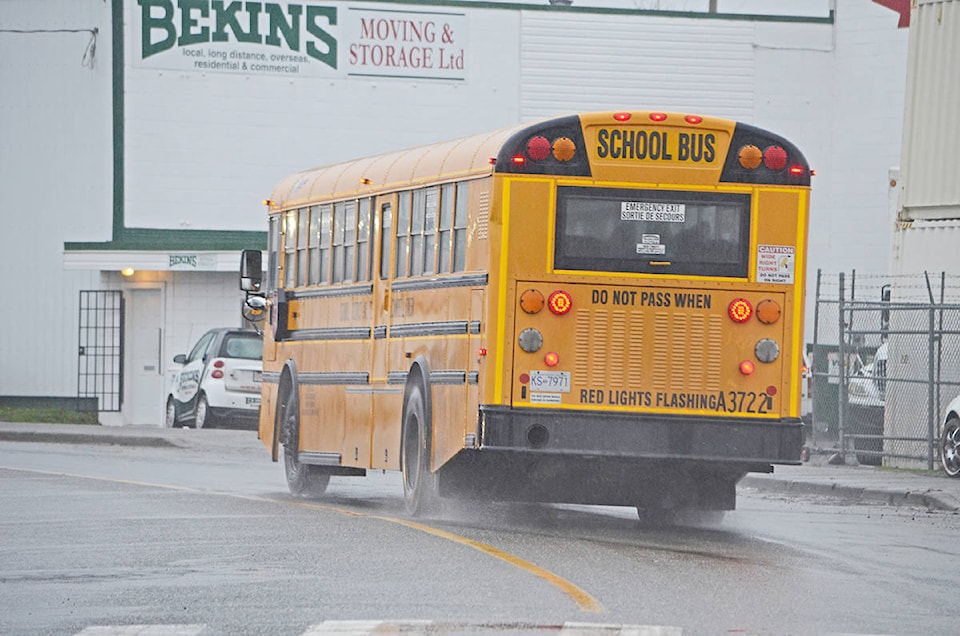The School District 72 board wanted more information about school buses and seat-beats, and they got it at their last meeting in December.
RELATED STORY: Campbell River School District calls for report on buses and seat-belts
Newly appointed district principal Phil Cizmic was given the task of finding out more for the board and delivered his report to trustees at the Dec. 18 meeting.
“It’s allowed me to learn about our transportation department and about things I didn’t know,” he said. “I definitely learned a lot about school bus safety and seat-belts – things I’ve taken for granted, things as an educator for the last 23 years I didn’t think about when I took my students onto a bus.”
Transport Canada has been undergoing a review of the issue since the fall. The topic was also the subject of a recent television expose on the question of bus safety and seat-belts.
RELATED STORY: Transport Canada to take new look at rules, research on school bus seat-belts
To find information, Cizmic spoke to district bus drivers, telling the board that every employee was eager to provide information.
“We have some amazing bus drivers in our district,” Cizmic said. “Our students are lucky to have the bus drivers that we have.”
He provided some local context for the trustees, telling them the district provides transportation for an average of 2,000 students on the fleet of 20 buses each day. The district makes more than 950 field trips a year and also provides transportation for special needs students
“Our students travel a lot in our buses,” he said.
Cizmic looked at data from the last 15 years and found there were no fatalities or serious injuries on local buses. The most common injuries were minor, often the result of slipping while getting in and out of buses. He also looked at information on a national scale. In Canada, there is an average on one fatality a year.
“We know that seat-belts save lives,” he said.
However, their effect varies depending on the nature of the accident. Belts tend to provide more safety, he said, for accidents like rollovers or side-impact collisions, but these are the least frequent types.
“Head-on collisions are the most common types of collisions,” he added.
In these cases, belts, especially two-point-connections belts – those with lap straps but no shoulder straps – can actually increase the likelihood of injuries. Cizmic pointed out how current bus design incorporates safety through higher backs and cushioning as well as having smaller windows to avoid passenger ejections.
Another consideration for the district would be how to ensure students wear belts should the district add them to buses.
There are also questions about what the outcome of the federal government review could mean. In the meantime, Cizmic talked about the ramifications of trying to alter the current fleet to add seat-belts.
“Not all buses can accommodate retro-fitting,” he said,
Any work would require engineering to make sure the structure of the bus does not change from any riveting or drilling. As well, only buses made after 2014 can be retrofitted. For the district, this only covers the two newest buses.
There are also questions about the cost. The estimate for a retrofit is $800 per bench seat, or about $22,000 per bus, while the cost of a new bus with seat-belts is approximately $150,000.
Cizmic found out belts would reduce buses’ passenger capacity, from three students to a seat down to two. One concern was that reduced carrying capacity could result in more students seeking other means of getting to and from school, raising subsequent safety questions from students opting for less safe means of transportation.
Trustees acknowledged the many issues that report raised for the district when considering seat-belts for its bus fleet.
“There’s just so much information that we don’t know and things that we just take for granted,” trustee Susan Wilson said, saying the report provided the board with some of the information they need. “I really appreciate the update.”
Trustee Joyce McMann, who brought the matter forward from the district parent advisory council (DPAC) to the Nov. 27 board meeting, asked if the board’s DPAC representative Kat Eddy could take the information back to parents.
